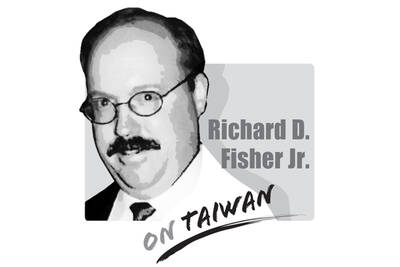Chinese academic Zhang Weiwei (張維為) recently said that after Taiwan is “unified” with China, “governing Taiwan would be easier than governing Hong Kong” as young Taiwanese are fond of using Chinese social media apps such as Xiaohongshu (小紅書, or “RedNote”). It would be easy to dismiss the Fudan University professor’s remarks as bluster, but it does highlight a worrisome trend — Chinese social media are infiltrating and spreading Beijing’s message and influence in Taiwan.
Cognitive warfare has long been one of the Chinese Communist Party’s major tactics to influence and manipulate domestic and international perceptions about China, with Chinese social media apps, such as TikTok (or Douyin 抖音) and Xiaohongshu, becoming tools to spread Chinese propaganda and disinformation. With the Chinese communist government controlling access to users’ data and strictly censoring content, these social media platforms, under the guise of entertainment and harmless digital interaction, aim to influence and reshape Taiwanese public opinion on cross-strait relations, as well encourage skepticism toward democratic allies such as the US.
Following a growing number of democratic nations raising alerts and imposing restrictions on Chinese social media, Taiwan in 2022 banned the use of Chinese apps in public-sector devices. However, their users in Taiwan have continued to grow. DataReportal estimated that as of early this year, there were 8.34 million TikTok users in Taiwan. Another report by a Ministry of Digital Affairs unit last year showed that more than one-fifth of Taiwanese adults used TikTok, with young people aged 18 to 29 making up more than 35 percent of the total.
Meanwhile, Xiaohongshu, which attracts young Taiwanese with its focus on beauty and lifestyle, had more than 3 million active users, Data.ai figures showed, with more than 1.27 million Taiwanese downloading the app last year, easily surpassing downloads of Facebook and Instagram.
Furthermore, as China escalates its military drills around Taiwan, a new wave of disinformation is spreading on those Chinese social media platforms. The National Security Bureau has warned that Beijing’s dissemination of misleading or controversial information jumped 60 percent last year from a year earlier, most of which could be found in media outlets frequented by young people.
For example, aerial photographs of Hualien Air Base that circulated on Xiaohongshu on Wednesday last week — a day after President William Lai’s (賴清德) first anniversary in office — have been identified to be post-processed fake “composites” designed to spark concern about intrusions or undetected spying that threaten Taiwanese defense. There has also been a growing number of Chinese streamers showing videos about Taiwan that aim to cause social unrest or even teach Chinese nationals how to illegally enter Taiwan.
For a democratic country, it is definitely a challenge to balance regulating social media and protecting freedom of speech. Aside from banning usage of Chinese social media on public-sector devices, the government has repeatedly urged people who use them to be cautious and alert to being influenced by Beijing’s “united front” propaganda.
More efforts should be made to promote media and information literacy to help the public navigate the complexities of social media and identify misinformation and disinformation. Meta Platforms was recently fined NT$1 million (US$33,412) for failing to disclose ad content creators’ identities and sources of funding under the Fraud Crime Hazard Prevention Act (詐欺犯罪危害防制條例). The government could also work with civil rights groups and media experts to extend the legal scope of digital affairs-related laws to increase the transparency of social media platforms’ operations, and to monitor, moderate and hopefully reduce manipulated information online that undermine Taiwan’s security and sovereignty.

On Sept. 3 in Tiananmen Square, the Chinese Communist Party (CCP) and the People’s Liberation Army (PLA) rolled out a parade of new weapons in PLA service that threaten Taiwan — some of that Taiwan is addressing with added and new military investments and some of which it cannot, having to rely on the initiative of allies like the United States. The CCP’s goal of replacing US leadership on the global stage was advanced by the military parade, but also by China hosting in Tianjin an August 31-Sept. 1 summit of the Shanghai Cooperation Organization (SCO), which since 2001 has specialized
In an article published by the Harvard Kennedy School, renowned historian of modern China Rana Mitter used a structured question-and-answer format to deepen the understanding of the relationship between Taiwan and China. Mitter highlights the differences between the repressive and authoritarian People’s Republic of China and the vibrant democracy that exists in Taiwan, saying that Taiwan and China “have had an interconnected relationship that has been both close and contentious at times.” However, his description of the history — before and after 1945 — contains significant flaws. First, he writes that “Taiwan was always broadly regarded by the imperial dynasties of
The Chinese Communist Party (CCP) will stop at nothing to weaken Taiwan’s sovereignty, going as far as to create complete falsehoods. That the People’s Republic of China (PRC) has never ruled Taiwan is an objective fact. To refute this, Beijing has tried to assert “jurisdiction” over Taiwan, pointing to its military exercises around the nation as “proof.” That is an outright lie: If the PRC had jurisdiction over Taiwan, it could simply have issued decrees. Instead, it needs to perform a show of force around the nation to demonstrate its fantasy. Its actions prove the exact opposite of its assertions. A
A large part of the discourse about Taiwan as a sovereign, independent nation has centered on conventions of international law and international agreements between outside powers — such as between the US, UK, Russia, the Republic of China (ROC) and Japan at the end of World War II, and between the US and the People’s Republic of China (PRC) since recognition of the PRC as the sole representative of China at the UN. Internationally, the narrative on the PRC and Taiwan has changed considerably since the days of the first term of former president Chen Shui-bian (陳水扁) of the Democratic